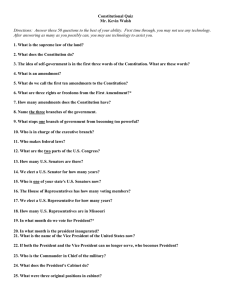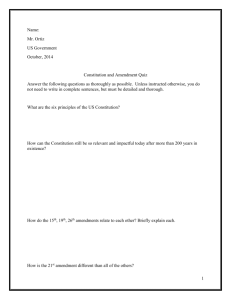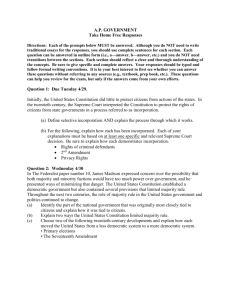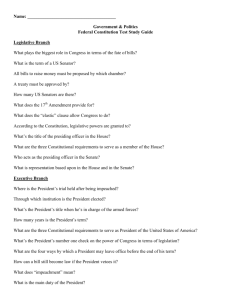More than just a phrase — The First Amendment
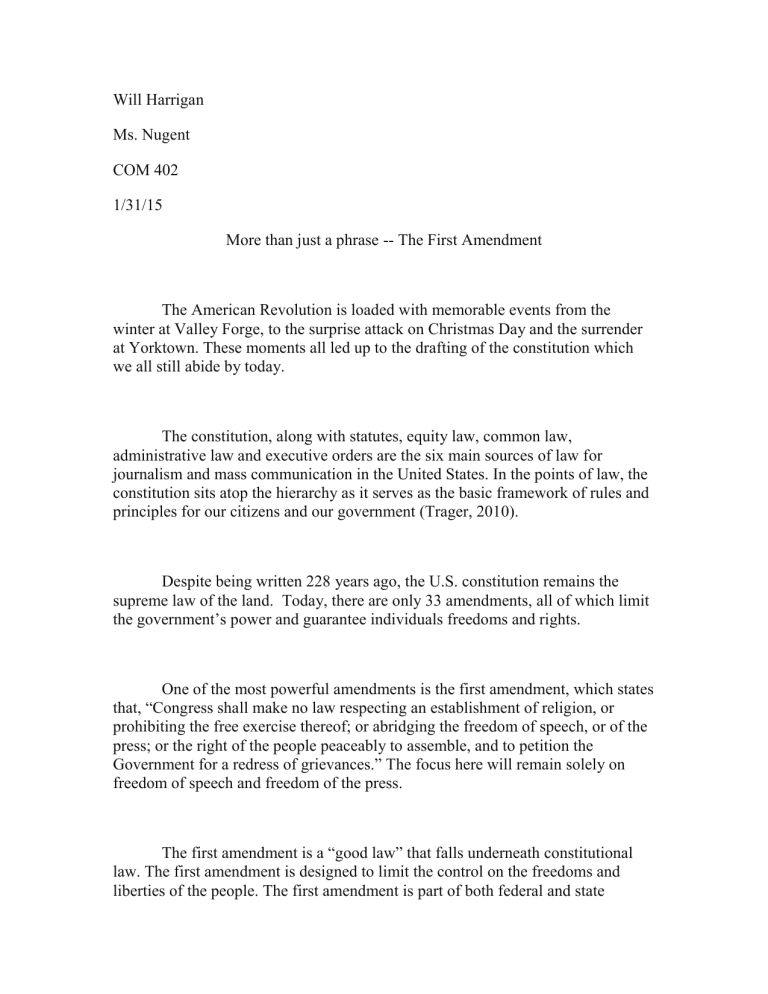
Will Harrigan
Ms. Nugent
COM 402
1/31/15
More than just a phrase -- The First Amendment
The American Revolution is loaded with memorable events from the winter at Valley Forge, to the surprise attack on Christmas Day and the surrender at Yorktown. These moments all led up to the drafting of the constitution which we all still abide by today.
The constitution, along with statutes, equity law, common law, administrative law and executive orders are the six main sources of law for journalism and mass communication in the United States. In the points of law, the constitution sits atop the hierarchy as it serves as the basic framework of rules and principles for our citizens and our government (Trager, 2010).
Despite being written 228 years ago, the U.S. constitution remains the supreme law of the land. Today, there are only 33 amendments, all of which limit the government’s power and guarantee individuals freedoms and rights.
One of the most powerful amendments is the first amendment, which states that, “Congress shall make no law respecting an establishment of religion, or prohibiting the free exercise thereof; or abridging the freedom of speech, or of the press; or the right of the people peaceably to assemble, and to petition the
Government for a redress of grievances.” The focus here will remain solely on freedom of speech and freedom of the press.
The first amendment is a “good law” that falls underneath constitutional law. The first amendment is designed to limit the control on the freedoms and liberties of the people. The first amendment is part of both federal and state
constitutions and has been that since it was first formed.
When constructing the first amendment of the Bill of Rights in 1787 the
Founding Fathers never envisioned that communicating with others would be done via text messaging, e-mailing and social media.
As our ways of communication have changed so have the laws surrounding the growing journalism and mass communication industry. Yes, freedom of speech and freedom of the press are still allowed and encouraged, but the right it is no longer absolute.
The U.S. Supreme Court has ruled many times that free speech can be limited to some degree. Although the written words in the constitution have remained the same, the interpretation of the first amendment has not yet been settled. But the Supreme Court has almost never limited the freedom of the press.
However, there are recent cases like Wikileaks where the U.S. government has asked Julian Assange, the founder of Wikileaks, to remove the leaked documents as they pose a threat to national security.
For example, in 1919 the Supreme Court ruled in the Schenck v. United
States case, “ Freedom of speech can be limited during wartime. The government can restrict expressions that “would create a clear and present danger that they will bring about the substantive evils that Congress has a right to prevent” (Bill of
Rights Institute).
This case is just one example of the types of speech that are not protected by the first amendment.
The Court has decided that the First Amendment provides no protection for obscenity, child pornography, or “fighting words.” It also doesn’t offer full protection to commercial speech, defamation speech that may be harmful to children, and public employees’ speech (Ruane, 3).
Although the constitution is atop the legal hierarchy, the Supreme Court
has had an increasing role in interpreting the phrase “freedom of speech.” The discretion of the Supreme Court justices is where much controversy lies in regards to freedom of speech.
In my opinion there’s a fine line between having the government regulating speech and them not regulating speech at all. Although they’re our some prior case rulings in the Supreme Court that I disagree with such as Texas v.
Johnson, where flag burning is considered symbolic speech, I agree with a lot of the rulings. If someone says something that poses a serious threat to our society and our people than I think action need to taken. However the government’s say should be very, very limited so that the government doesn’t end up totally controlling our speech. As a society, we should keep the governments power as limited as possible.
The debate between weighing constitutional law or common law more than another is a tricky one. Both continue to be an integral part of our legal system, but the constitution reigns supreme. However, I think more weight should be put on common law.
Common law rests on prior court rulings, or precedent. It is focused on laws locally, and it keeps our community in order. Another benefit of common law is that lower courts don’t always have to adhere to the power of stare decisis. A judge may simply ignore precedent. Furthermore, courts can distinguish from precedent if the differences between cases outweigh similarities.
Another strength is that common law is more reflective of society at that time. For example, it has led the way for change of segregation such as Title IX.
Constitutional law on the other hand is more ambiguous and subject to interpretation and can be considered as outdated.
Constitutional law and common law differs from other sources of law.
Equity law, statutes, administrative rules, and executive orders are other sources that make up our current criminal justice system.
Equity law is the idea that the harsh rules of common law prevented justice and fairness. Judges are the ones who make equity law. However unlike common law, it is not solely based on precedent.
Statutes are another source of law that are written laws enforced by the government including things like copyright, broadcasting and advertising rules.
These laws are enacted the U.S. congress in the legislative branch.
Administrative rules are the wide range of agencies within the federal government like the Department of Homeland Security, the Department of
Counter Terrorism, etc. Even the FCC is considered to be apart of administrating ruling as it oversees electronic communication.
Finally, executive orders are actions taken by the president, governors or mayors. These officials have the power to make laws as long as it is constitutional.
One example of a recent executive order is by President Obama who ordered temporary legal status to millions of illegal immigrants in 2014.
The laws and rules that make up the United State are derived from six sources: constitution, statutes, equity law, common law, administrative law and executive orders. Although we still abide by the constitution, interpretations of amendments particularly the first, has become a subject of controversy. Is it right for the government to have some say in controlling speech? It certainly isn’t what the Founding Fathers fought for, but given the drastic changes in society, the government may eventually become more involved in what is morally and ethically acceptable in regards to freedom of speech and freedom of the press.
Works Cited
Freedom of Speech: General. (n.d.). Retrieved February 1, 2015, from http://billofrightsinstitute.org/resources/educator-resources/landmark-
cases/freedom-of-speech-general/
Ruane, K. (2014, September 8). Freedom of Speech and Press: Exceptions of the
First Amendment. Retrieved February 1, 2015, from https://www.fas.org/sgp/crs/misc/95-815.pdf
Trager, R., & Russomanno, J. (2010). The Rule of Law. In The law of journalism and mass communication (2nd ed.). Washington, D.C.: CQ Press.


